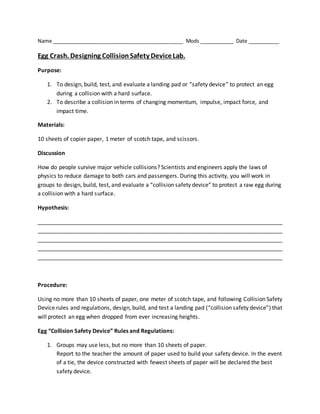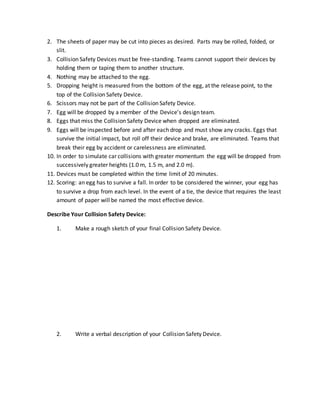Egg crash. designing collision safety device lab
- 1. Name ______________________________________________ Mods ____________ Date ___________ Egg Crash. Designing Collision Safety DeviceLab. Purpose: 1. To design, build, test, and evaluate a landing pad or ŌĆ£safety deviceŌĆØ to protect an egg during a collision with a hard surface. 2. To describe a collision in terms of changing momentum, impulse, impact force, and impact time. Materials: 10 sheets of copier paper, 1 meter of scotch tape, and scissors. Discussion How do people survive major vehicle collisions? Scientists and engineers apply the laws of physics to reduce damage to both cars and passengers. During this activity, you will work in groups to design, build, test, and evaluate a ŌĆ£collision safety deviceŌĆØ to protect a raw egg during a collision with a hard surface. Hypothesis: ______________________________________________________________________________ ______________________________________________________________________________ ______________________________________________________________________________ ______________________________________________________________________________ ______________________________________________________________________________ Procedure: Using no more than 10 sheets of paper, one meter of scotch tape, and following Collision Safety Device rules and regulations, design, build, and test a landing pad (ŌĆ£collision safety deviceŌĆØ) that will protect an egg when dropped from ever increasing heights. Egg ŌĆ£Collision Safety DeviceŌĆØ Rules and Regulations: 1. Groups may use less, but no more than 10 sheets of paper. Report to the teacher the amount of paper used to build your safety device. In the event of a tie, the device constructed with fewest sheets of paper will be declared the best safety device.
- 2. 2. The sheets of paper may be cut into pieces as desired. Parts may be rolled, folded, or slit. 3. Collision Safety Devices must be free-standing. Teams cannot support their devices by holding them or taping them to another structure. 4. Nothing may be attached to the egg. 5. Dropping height is measured from the bottom of the egg, at the release point, to the top of the Collision Safety Device. 6. Scissors may not be part of the Collision Safety Device. 7. Egg will be dropped by a member of the DeviceŌĆÖs design team. 8. Eggs that miss the Collision Safety Device when dropped are eliminated. 9. Eggs will be inspected before and after each drop and must show any cracks. Eggs that survive the initial impact, but roll off their device and brake, are eliminated. Teams that break their egg by accident or carelessness are eliminated. 10. In order to simulate car collisions with greater momentum the egg will be dropped from successively greater heights (1.0 m, 1.5 m, and 2.0 m). 11. Devices must be completed within the time limit of 20 minutes. 12. Scoring: an egg has to survive a fall. In order to be considered the winner, your egg has to survive a drop from each level. In the event of a tie, the device that requires the least amount of paper will be named the most effective device. Describe Your Collision Safety Device: 1. Make a rough sketch of your final Collision Safety Device. 2. Write a verbal description of your Collision Safety Device.
- 3. Problems Encountered: 1. List the problems your group encountered and modifications you made to Collision Safety Device. 2. List your suggestions for improving your Collision Safety Device. Crash test questions: 1. How do people survive major collisions? 2. How does physics explain the effectiveness of seat belts and airbags?
- 4. Conclusion: Please write 4-6 sentences.




